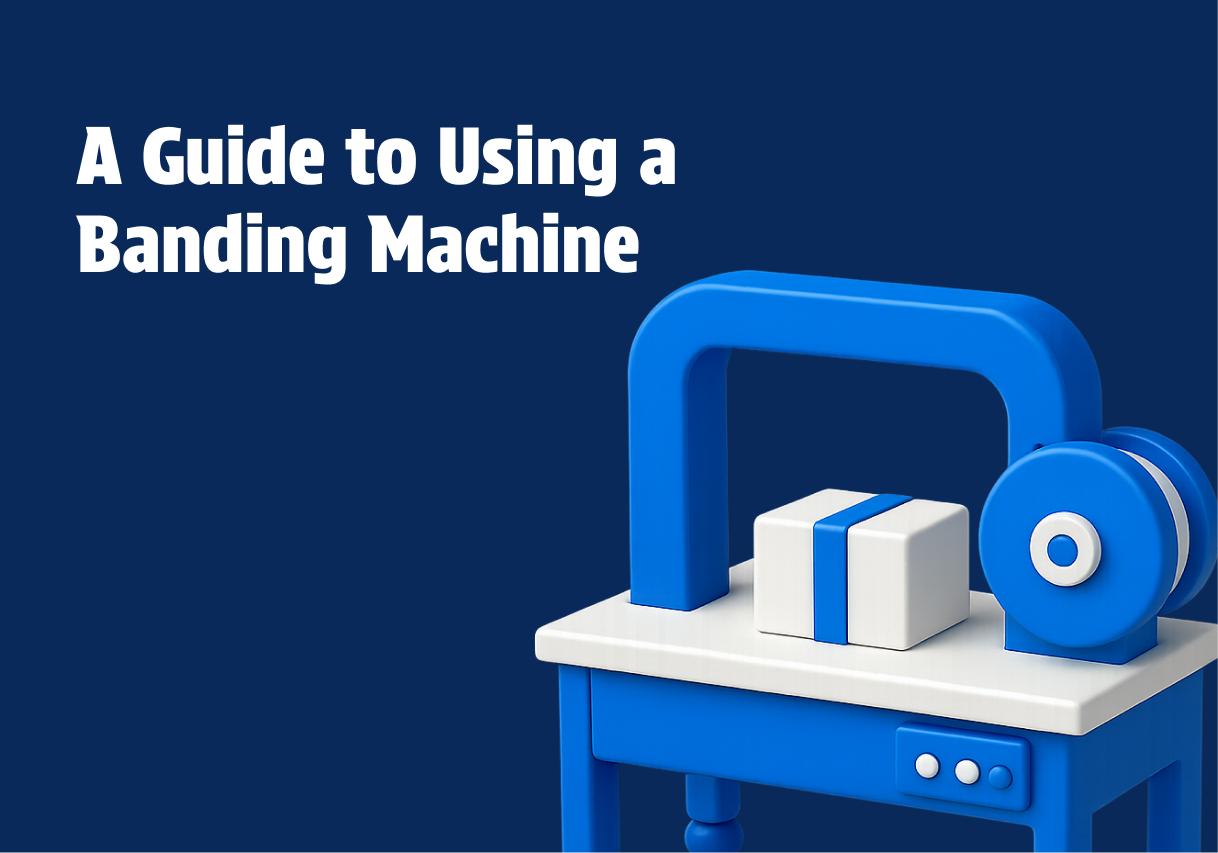Frustration often arises when a banding machine fails to perform as expected—uneven tension, wasted material, or unexpected stoppages can significantly slow down packaging operations.
When you get it right, a banding machine is one of the simplest tools to keep your packaging moving smoothly and your products looking great. If you want to know how to use a banding machine effectively, you are in the right place.
Banding vs. Strapping: What’s the Difference?
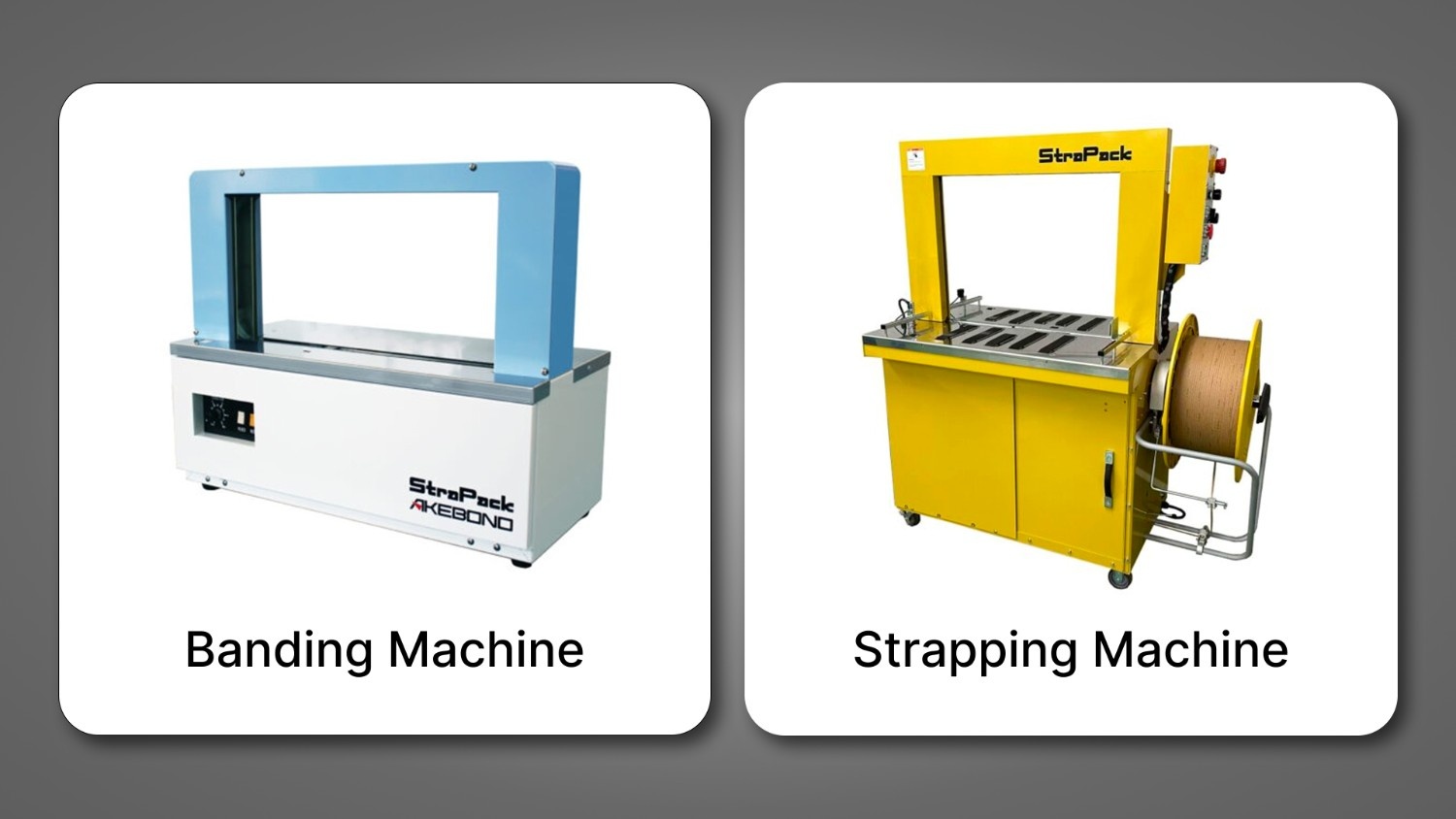
While banding and strapping machines might seem similar, they serve different purposes and suit different packaging needs.
- Banding machines use narrow, flat bands (often paper or plastic) to bundle lighter, smaller, or more delicate products.
For example, the OB560N is a high-speed banding machine, capable of up to 30 cycles per minute. Soft or elastic bundles can be banded without sacrificing speed. It applies banding to packages as small as 30mm (1-1/8″) wide x 10mm (3/8″) high and as big as 420mm (16-1/2″) wide x 210mm (8-1/4″) high.
Either paper or film tape can be used without changing any parts. Its new track design allows the use of 60 micron thick film, reducing cost and waste.
- Strapping machines use thicker, stronger straps (usually polypropylene or polyester) designed to secure heavier loads like pallets, large boxes, or industrial shipments.
For example, the SQ-800FB(KB) offers reliability with the option of using 0.5-0.6mm thickness paper straps. It’s fast with fewer moving parts, which allows for a low-maintenance operation. It also has an adjustable conveyor speed that allows for various line configurations, with self-loading and auto-refeed options.
What is a Banding Machine?
A banding machine is a packaging tool that wraps a narrow band, typically made of paper or plastic, around products to securely hold them together.
Unlike heavier strapping, banding applies just enough tension to bundle items neatly without damaging them, making it perfect for smaller, lighter, or delicate goods.
Banding machines come in several types based on their operation style, automation level, and application needs. Here are the most common types of banding machines used across industries.
Along with the standalone, semi-automatic, and fully automatic machines, there are other specialized types of banding machines designed to meet unique packaging needs and production scales.
1. Manual Banding Machines
These machines are operated entirely by hand, with manual tensioning and sealing. No electricity or automation is involved. These are best used for low-volume bundling and prototyping or sample packaging. These are mostly common in small workshops, artisan producers, and mobile setups.
2. Semi-Automatic Banding Machines
These machines require an operator to place the product, after which the system automatically feeds, tensions, and seals the band with minimal manual effort. Usually activated via a button or a foot pedal. These are best for medium-volume, repetitive bundling and variable product sizes. These are mostly common in print shops, mid-sized food packaging lines, and logistics operations.
3. Print-and-Band Machines (Integrated Print & Apply)
These machines band products while printing data (e.g., logo, barcode) directly on the band. It uses thermal or inkjet print modules integrated with the banding head. This is best used for branding and traceability in one step. The labeling must be clean and tamper-evident, in this case. These are mostly common in food & pharma packaging, cosmetics, and high-end retail.
How Banding Machines Work
Banding machines automate the process of securely wrapping products with bands, ensuring consistent tension and neat packaging. Here’s a quick look at the typical banding cycle:
- Place the product: Position the item inside the machine’s arch manually or let the conveyor feed it automatically.
- Wrap the band: The machine feeds a strip of paper or plastic band around the product.
- Seal the band: The band is sealed, usually by heat or ultrasonic welding, holding the product firmly in place.
- Remove the package: The finished bundle is either manually taken out or automatically moved along the line.
Banding is a versatile packaging solution that lets you print on-demand information on the band for labeling, efficiently bundle multiple items together, add custom logos or messaging for branding, and securely seal products with the right tension to keep them protected.
How to Use a Banding Machine?
Whether you're working with a manual, semi-automatic, or fully automatic banding machine, the basic principles remain the same: feed the product, secure it with the right band material, and ensure clean, consistent tension with every cycle.
Step 1: Assess Your Bundling Requirements
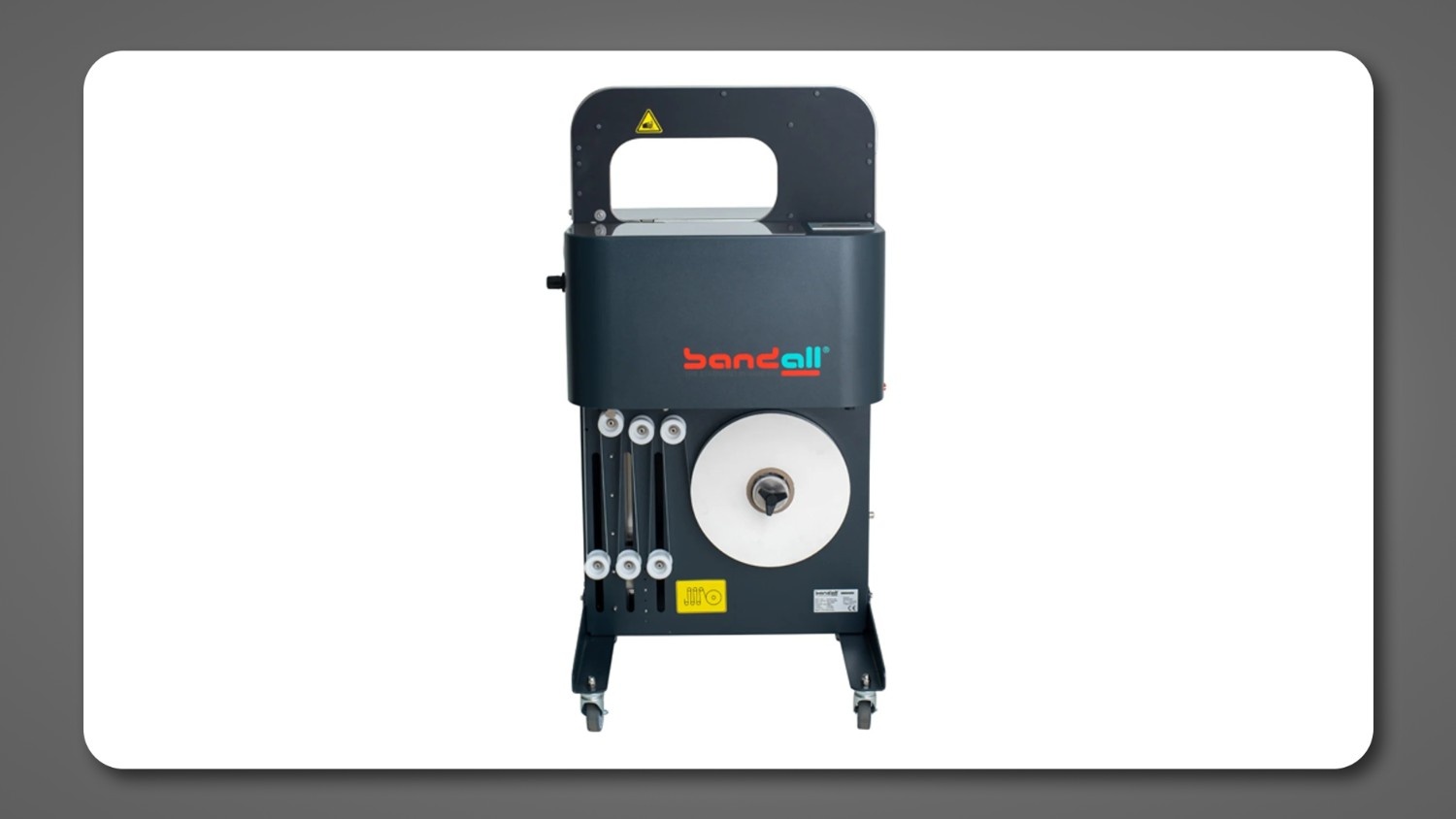
Before even using the machine, get clear on what you’re bundling:
- Product Dimensions and Weight: Bandwidth and tension settings depend heavily on product size and fragility. Typical band widths range from 5mm (3/16”) to 25mm (1”), with heavier bundles requiring wider bands.
- Bundle Size: How many items are in each bundle? Small product bundles (like printed materials or food boxes) usually use narrow bands; larger palletized loads might need wider, stronger banding or strapping.
- Production Volume: Manual banding machines work well for low-volume operations (under 50 bundles/hour), while semi-automatic and fully automatic banding machines handle medium to high volumes (100+ bundles/hour) with much greater speed and consistency.
Step 2: Choosing the Right Band Material and Size
Once you’ve selected the right band material and machine type for your specific needs, you need to understand the material you require, along with the banding machine specifications.
1. Paper Bands
These are gentle and eco-friendly, but less durable than plastic or film bands. These are available as FSC-certified Kraft paper in natural brown and white. At the same time, white MC paper offers a smooth, polished finish for a sleeker appearance. You can also opt for laminated paper options, which add extra strength and protection.
2. Plastic Bands
These are typically made from polypropylene or polyester. They provide superior strength and resistance to moisture compared to paper. It is durable and ideal for applications that demand extra strength and reliability.
3. Film Bands
Films offer strong, moisture-resistant wrapping that tightly secures products. They use less material due to their high strength, making packaging more cost-effective. They provide a sleek design that supports branding, bundling, labeling, and sealing.
For better size and width selection, consider the dimensions and weight of your products to choose bands that provide secure wrapping without causing damage or unnecessary material use.
- Width: Narrow bands (5-10 mm) for small or fragile items; wider bands (15-25 mm) for heavier bundles.
- Thickness: Typically ranges from 0.3mm to 0.6mm. Thicker bands increase strength but may require machines with higher sealing capacity.
Pro Tip: Always check compatibility between your band thickness and the machine sealing system. Using bands that are too thick or too thin for your machine can cause jams or poor seals.
Step 3: Machine Setup
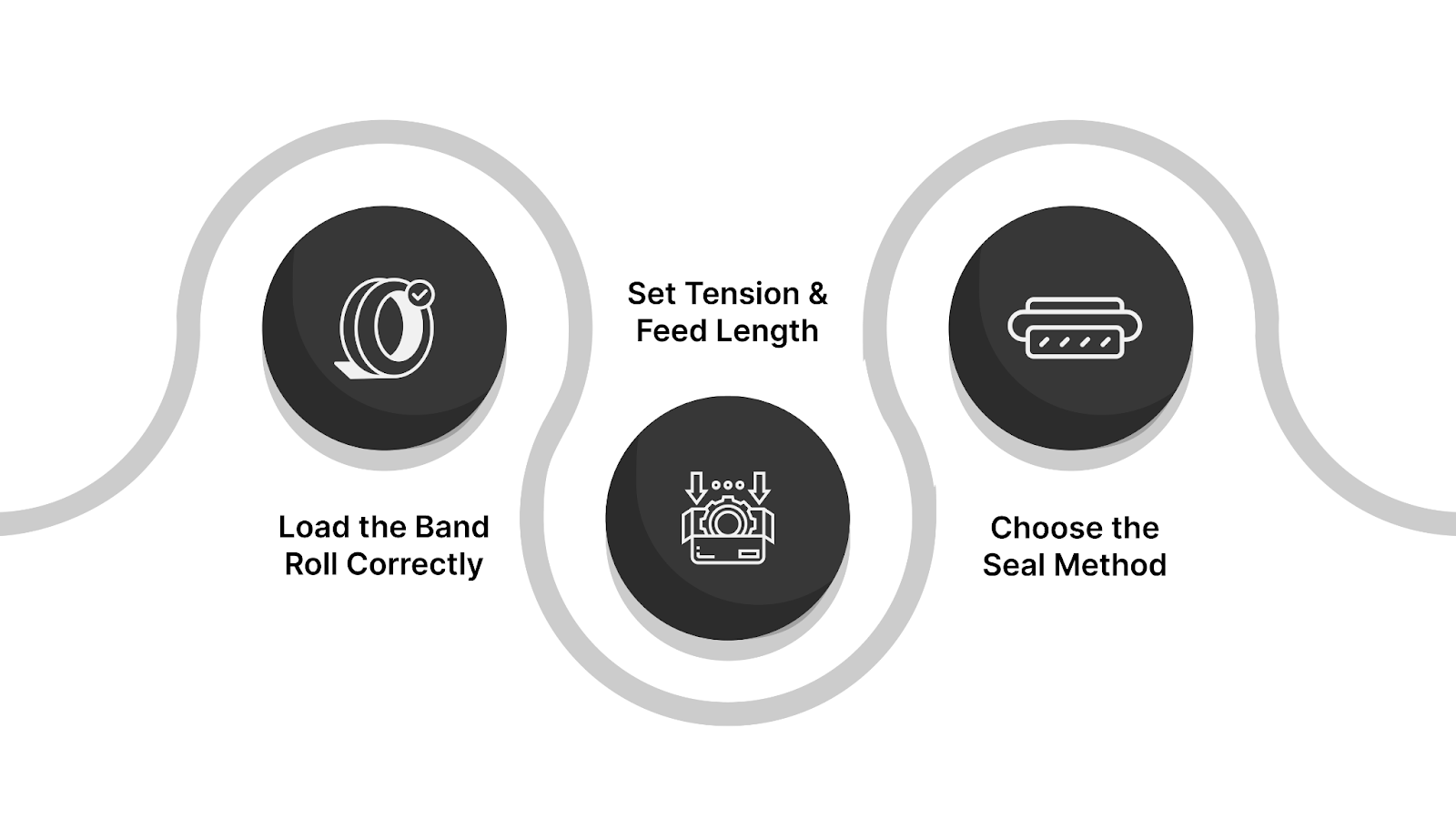
Position the machine, load the band roll, and adjust tension and sealing settings based on your product specifications. Let’s break it down better for you to understand.
1. Load the Band Roll Correctly
Unwind the band roll and place it on the spool with proper orientation (check the machine manual). Thread the band through rollers, guides, and sealing jaws carefully to avoid twists or folds.
2. Set Tension and Feed Length
Adjust the tension to hold the bundle without crushing or damaging the product securely. Fragile items require low tension (10-20 N), while robust bundles can handle 50+ N.
Set the band length to comfortably wrap around the product plus a small overlap. Too long wastes material; too short causes incomplete wraps.
3. Choose the Seal Method
Heat sealing is the most suitable method for plastic bands. Ensure to adjust the temperature for clean, strong seals. Too hot damages bands; too cold results in weak seals.
You can also use ultrasonic methods for heat-sensitive materials, and tune the vibration frequency as per the material thickness.
Step 4: Operate the Machine
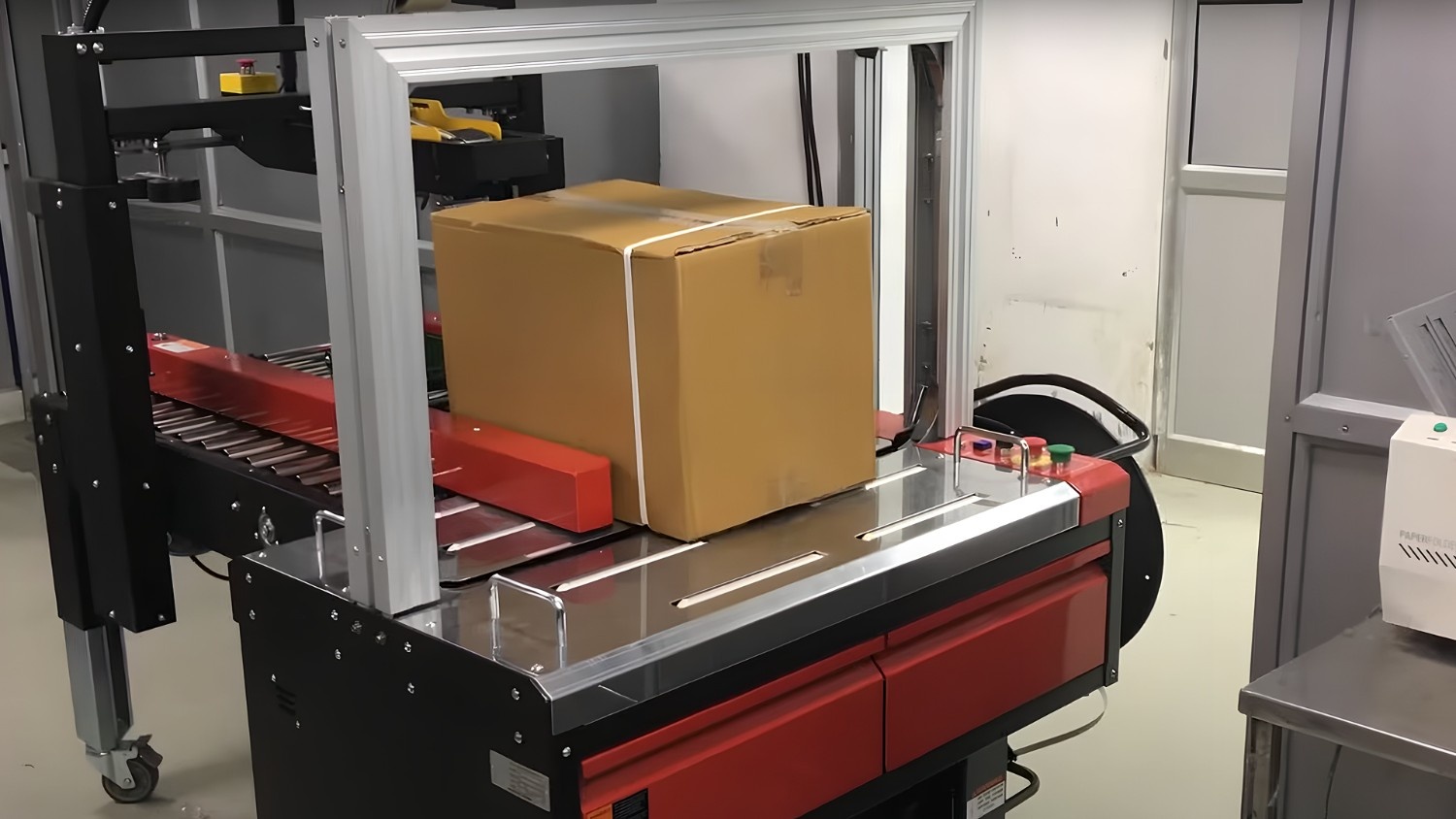
Once your machine is set up with the right band and settings, it’s time to start banding. Place the product in position and activate the cycle (manual button, foot pedal, or automatic sensor, depending on your machine type).
- Consistent Loading: Always place bundles squarely and centered within the banding loop for even tension.
- Start Cycle Smoothly: On semi/auto machines, avoid abrupt starts to prevent band misfeeds.
- Adjust Settings for Product Changes: When switching product types, retune tension, feed length, and sealing temperature.
Product Spotlight: StraPack OB-360N Banding Machine Features
To put these operating principles into perspective, here’s a look at the StraPack OB-360N, a reliable, semi-automatic banding machine widely used by many packaging industries across the US. Its technical specifications highlight the features that support smooth operation and adaptability across different product sizes and packaging needs.
When you understand how a solid machine like the StraPack OB-360N runs and what it’s capable of, it becomes obvious why picking the right banding equipment matters.
What are the Benefits of Using a Banding Machine?
Banding offers a range of advantages that help with your packaging process while supporting sustainability and cost savings. Here are some of the benefits of using a banding machine from brands like Bandall or StraPack.
- Material Savings: Reduces packaging material usage by up to 80% compared to traditional methods.
- Cost Efficiency: Lowers costs through material savings and improved operational efficiency.
- Energy Efficiency: It consumes less energy than alternatives like shrink-wrap tunnels.
- Sustainability: Enables the use of recyclable or biodegradable banding materials.
- Environmental Impact: Helps shrink your company’s environmental footprint.
- Regulatory Compliance: Simplifies compliance with current packaging regulations, including Packaging and Packaging Waste Regulation (PPWR).
Maintenance and Safety of a Banding Machine
Regular maintenance and strict safety practices are highly essential to keep your banding machine running efficiently and to prevent unexpected downtime.
Proper care extends the machine’s lifespan, ensures consistent packaging quality, and protects operators from injury by reducing the risk of accidents.
- Daily Cleaning: Remove dust, adhesive buildup, and debris around rollers and sealing jaws.
- Seal Element Checks: Replace heating wires, ultrasonic horns, or sealing belts per the manufacturer’s schedule.
- Lubricate Moving Parts: Follow your machine’s maintenance manual for lubrication intervals.
- Safety: Keep guards in place, never reach into the machine during operation, and wear gloves when handling sharp bands.
Why Buy from John Maye Company?
When it comes to banding machines and packaging solutions in the Midwest, John Maye Company stands out as the go-to partner. Whether you’re bundling small retail items or securing heavy pallets, they offer a full range of banding and strapping equipment to fit your exact needs.
With a fast shipping process, most orders leave within 24 hours, so you can keep your packaging line running smoothly without delays. Plus, their expert service team provides on-site repairs and remote support to minimize downtime and keep your operations efficient.
FAQs
1. What causes banding jams, and how do I prevent them?
Band jams typically happen when the band material is misaligned, twisted, or too thick for the machine’s guides. To prevent this, ensure proper threading by following the feed path precisely, use compatible band thickness, and routinely clean guides and rollers to remove buildup.
2. How tight should band tension be for fragile vs. firm items?
Tension should vary by product: use low tension (10–20 N) for delicate or flexible items to avoid damage, and higher tension (up to 30 N) for firmer bundles. Always run test cycles with sample items to dial in the correct tension setting.
3. What's the difference between the sealing methods used by banding machines?
Heat sealing melts the band ends together and works well for plastic bands, while ultrasonic sealing bonds using vibration without heat, ideal for heat-sensitive or printed paper bands. Both create secure closures but suit different material types.
4. How do machines handle different product sizes without retooling?
Many fully-automatic systems use adjustable photo sensors, smart conveyors, or product measuring systems. These allow seamless size changes during operation, without needing physical adjustments. Multi-width band configurations also let operators switch band widths quickly.
5. Do users still use manual strapping tools in the age of automation?
Yes, especially in small-scale or mobile settings. Many warehouse workers still use hand-operated tensioners and ratchet tools for plastic or steel bands when automation isn’t practical. However, they require skill to avoid over-tightening or mis-cutting the bands.
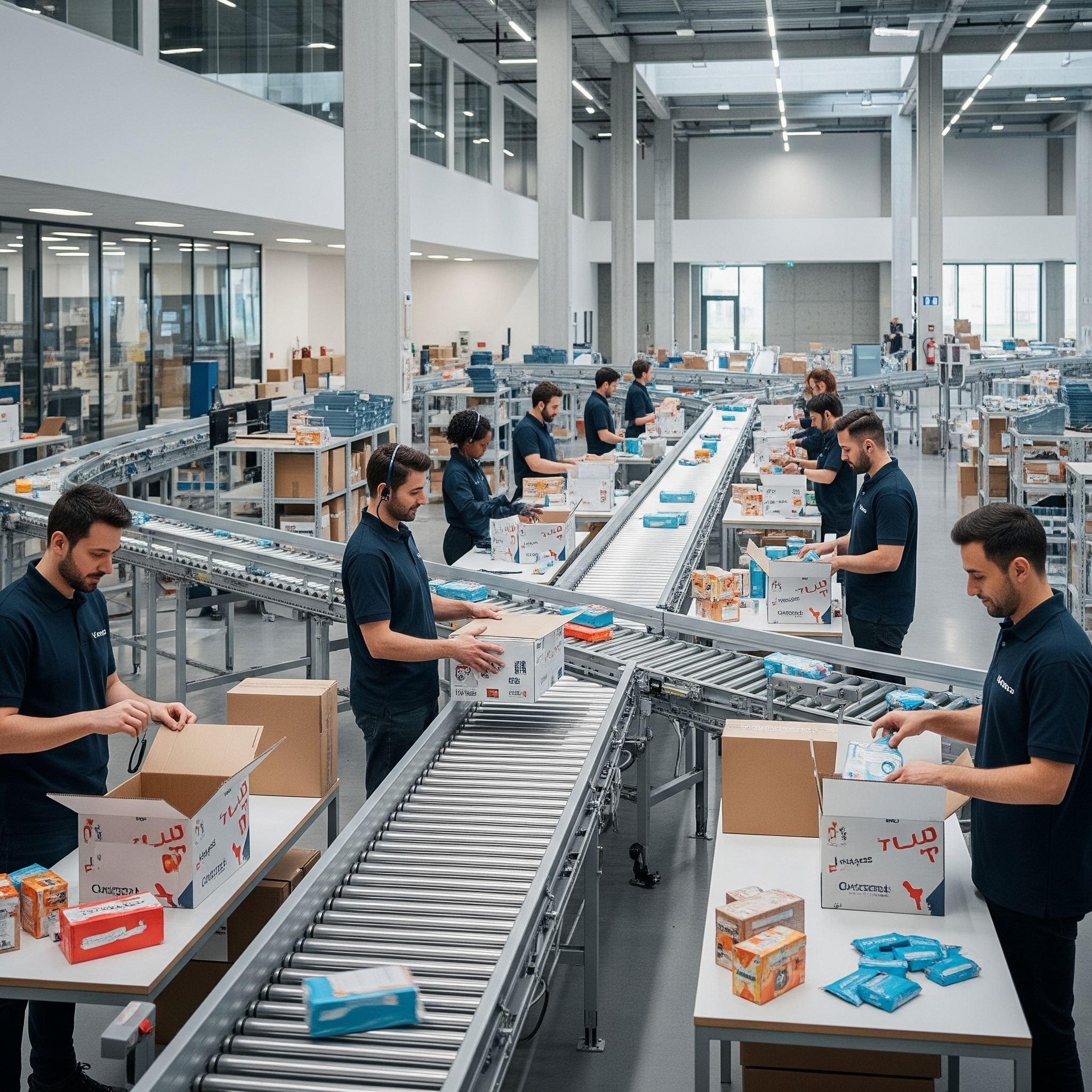
Blogs
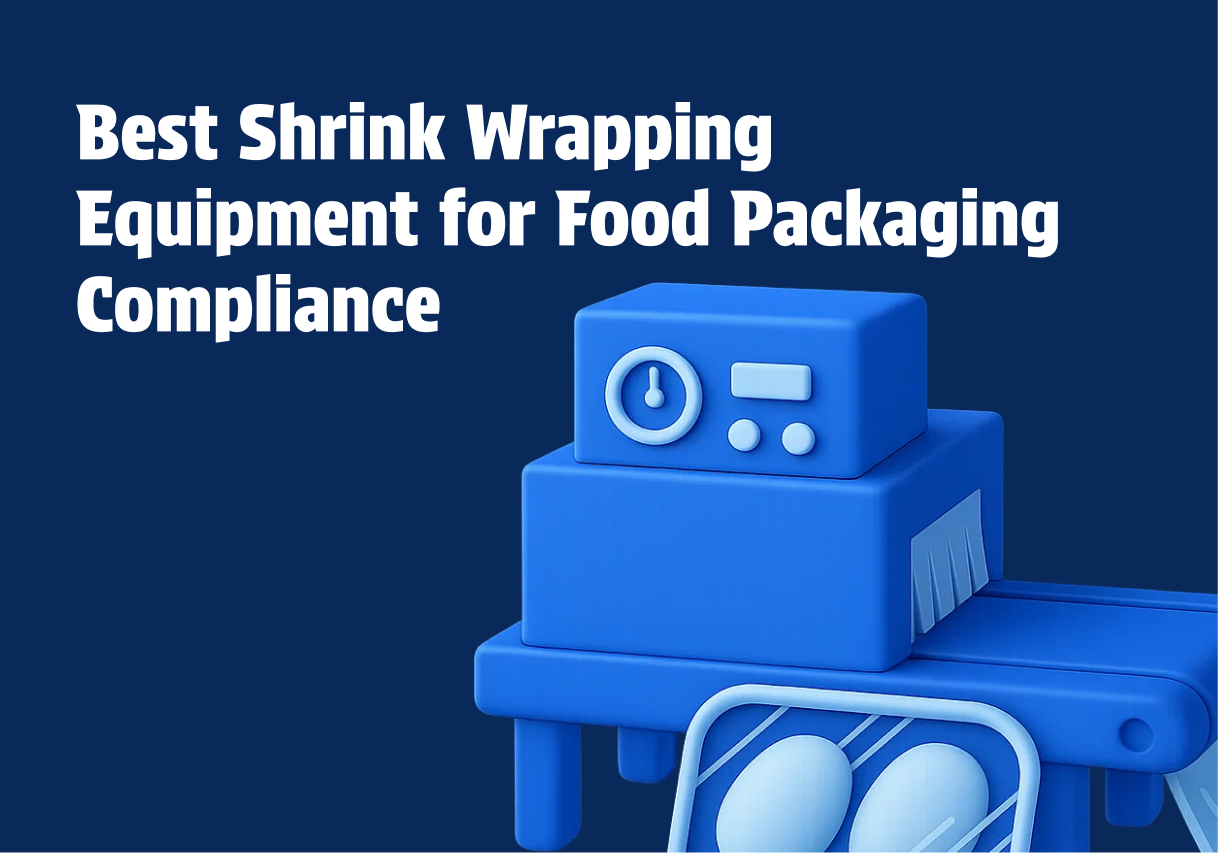
Best Shrink Wrap Machines for Your Business
Discover the best shrink wrapping equipment for food packaging compliance. Conflex offers high automation. Increase efficiency now!
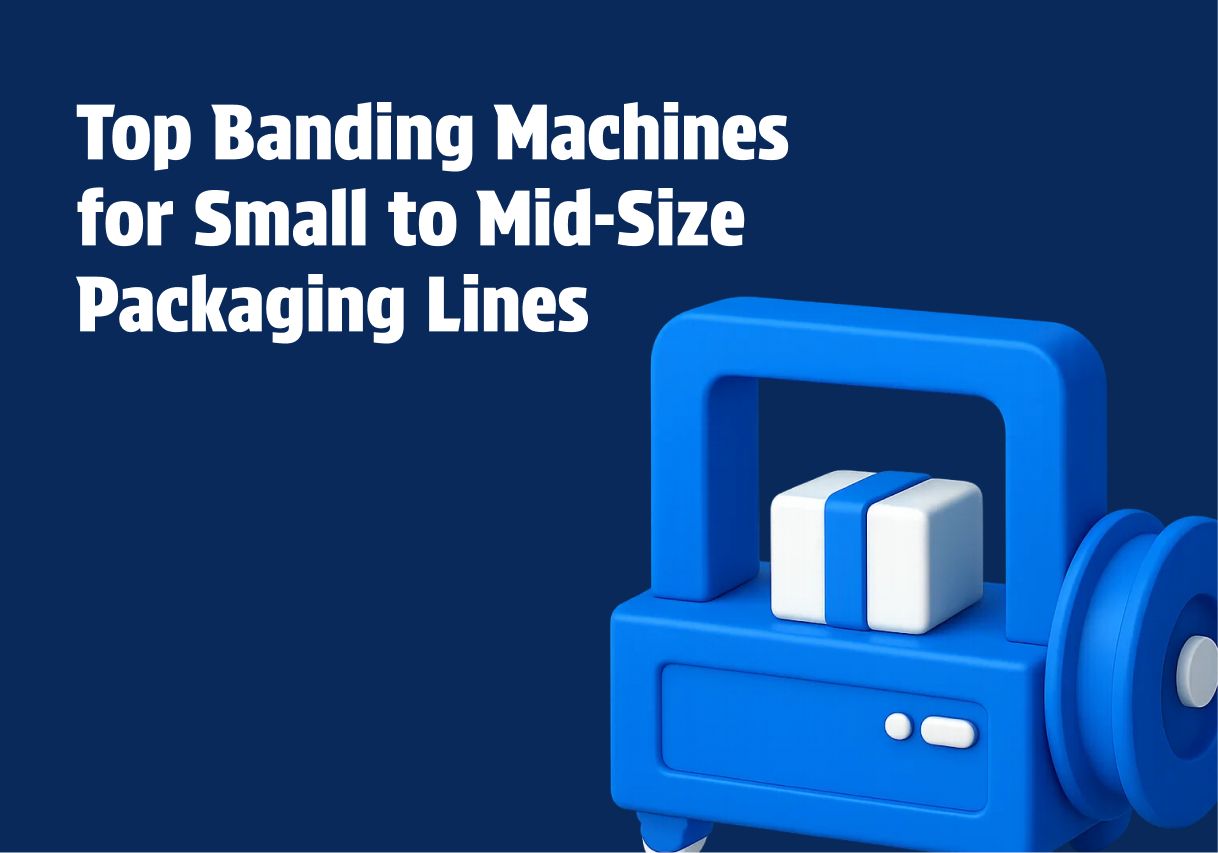
Top Banding Machines for Packaging Solutions
Find top banding machines for small to mid-size packaging lines! Discover flexible automation options and sustainability features. Optimize efficiency today!

Best Pallet Wrapping Machines for Manufacturing Plants 2025
Explore the best pallet wrapping machines for manufacturing plants in 2025. Learn how to choose, compare key models, and reduce wrapping costs.
